TRENDNET TEW610-611 108Mbps 802.11g MIMO Wireless miniPCI Module User Manual
TRENDNET, INC. 108Mbps 802.11g MIMO Wireless miniPCI Module
TRENDNET >
Users Manual
1
108Mbps 802.11g MIMO Wireless miniPCI
Module
User's Guide
2
Federal Communication Commission Interference Statement
This equipment has been tested and found to comply with the limits for a Class B
digital device, pursuant to Part 15 of the FCC Rules. These limits are designed to
provide reasonable protection against harmful interference in a residential
installation. This equipment generates, uses and can radiate radio frequency
energy and, if not installed and used in accordance with the instructions, may
cause harmful interference to radio communications. However, there is no
guarantee that interference will not occur in a particular installation. If this
equipment does cause harmful interference to radio or television reception, which
can be determined by turning the equipment off and on, the user is encouraged to
try to correct the interference by one of the following measures:
- Reorient or relocate the receiving antenna.
- Increase the separation between the equipment and receiver.
- Connect the equipment into an outlet on a circuit different from that
to which the receiver is connected.
- Consult the dealer or an experienced radio/TV technician for help.
This device complies with Part 15 of the FCC Rules. Operation is subject to the
following two conditions: (1) This device may not cause harmful interference, and
(2) this device must accept any interference received, including interference that
may cause undesired operation.
FCC Caution: Any changes or modifications not expressly approved by the party
responsible for compliance could void the user's authority to operate this
equipment.
IMPORTANT NOTE:
FCC Radiation Exposure Statement:
This equipment complies with FCC radiation exposure limits set forth for an
uncontrolled environment. This equipment should be installed and operated with
minimum distance 20cm between the radiator & your body.
This transmitter must not be co-located or operating in conjunction with any other antenna
or transmitter.

3
This device is intended only for OEM integrators under the following conditions:
1) The antenna must be installed such that 20 cm is maintained between the antenna
and users, and
2) The transmitter module may not be co-located with any other transmitter or antenna.
As long as 2 conditions above are met, further transmitter test will not be required.
However, the OEM integrator is still responsible for testing their end-product for any
additional compliance requirements required with this module installed (for example,
digital device emissions, PC peripheral requirements, etc.).
IMPORTANT NOTE: In the event that these conditions can not be met (for example
certain laptop configurations or co-location with another transmitter), then the FCC
authorization is no longer considered valid and the FCC ID can not be used on the final
product. In these circumstances, the OEM integrator will be responsible for re-evaluating
the end product (including the transmitter) and obtaining a separate FCC authorization.
End Product Labeling
This transmitter module is authorized only for use in device where the antenna may be
installed such that 20 cm may be maintained between the antenna and users (for
example : Access Point, Router…etc.). The final end product must be labeled in a visible
area with the following: “Contains TX FCC ID: S9ZTEW610-611”.
TRENDnet declares that TEW610-611, ( FCC ID: S9ZTEW610-611 ) is limited in CH1~CH11 for
2.4 GHz by specified firmware controlled in U.S.A.
Manual Information That Must be Included
The OEM integrator has to be aware not to provide information to the end user
regarding how to install or remove this RF module in the users manual of the end
product which integrate this module.
The users manual for OEM integrators must include the following information in a prominent location “ IMPORTANT NOTE:
To comply with FCC RF exposure compliance requirements, the antenna used for this transmitter must be installed to provide a
separation distance of at least 20 cm from all persons and must not be co-located or operating in conjunction with any other
antenna or transmitter.
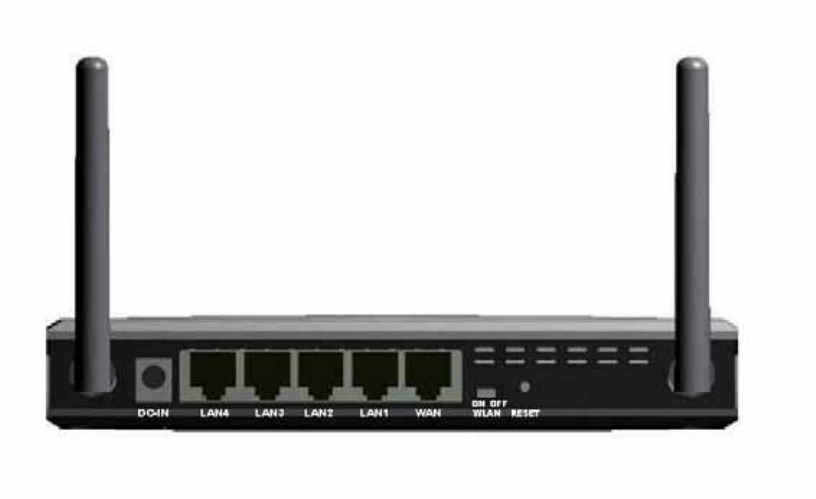
Distance between two external antennas on housing is 15cm, and PLS refer to the
following picture for antenna position.
4
4
Table of Contents
Federal Communications Commission Interference statement____1
Getting Started_____________________________________________4
About Your 802.11g/b WLAN MIMO mPCI______________________4
Configuring Wireless Security_______________________________4
Configuring Security_____________________________________4
Configuring WEP__________________________________________4
Configuring WPA-PSK______________________________________7
Configuring WPA__________________________________________8
Configuring 802.1x_______________________________________8
Configuring 802.1x – EAP-MD5_____________________________8
Configuring 802.1x – EAP-LEAP____________________________9
Configuring 802.1x – EAP-PEAP____________________________9
Configuring 802.1x – EAP-TLS_____________________________11
Configuring 802.1x – EAP-TTLS___________________________13
5
Getting Started
This chapter introduces the module and prepares you to use the Wireless Utility.
About Your 802.11g WLAN MIMO mPCI
The Module is an IEEE 802.11b, and 802.11g compliant wireless LAN adapter. With the Module,
you can enjoy wireless mobility within almost any wireless networking environment.
The following lists the main features of your Module.
9 Your Module can communicate with other IEEE 802.11b/g compliant wireless devices.
9 Automatic rate selection.
9 Standard data transmission rates up to 54 Mbps.
9 Proprietary Atheros transmission rates of 108 Mbps
9 Offers 64-bit, 128-bit and 152-bit WEP (Wired Equivalent Privacy) data encryption for network
security.
9 Supports IEEE802.1x and WPA (Wi-Fi Protected Access).
9 Low CPU utilization allowing more computer system resources for other programs.
9 Support external antennas
Configuring Wireless Security
This chapter covers the configuration of security options in the Wireless Utility.
Configuring Security
You can configure your security settings at any time. Simply select the profile you wish to edit
under the [Profile] tab, select [Properties] and then choose [WLAN Security]. You are also
presented with the option to configure security during the profile creation process. Whether
changing the security settings of an existing profile or creating a new profile, the steps to configure
your security settings remain the same.
Configuring WEP
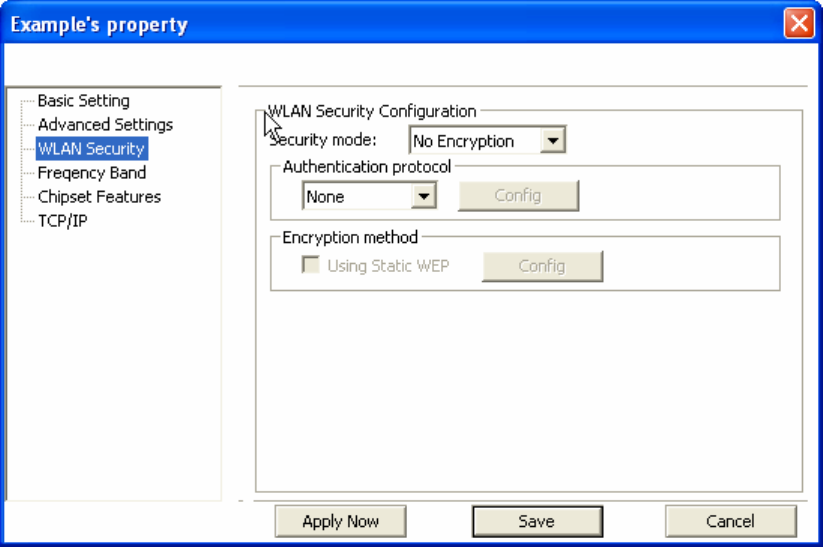
6
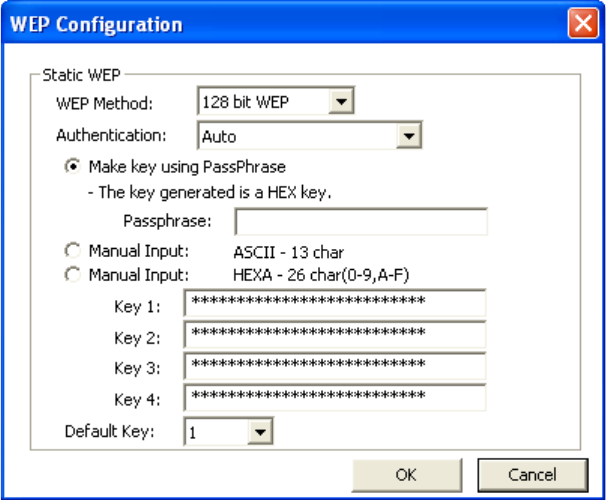
7
1. Select [WEP] under [Security Mode]
2. Put a check mark next to [Using Static WEP]
3. Click [Config]. You will then see the screen below.
4. [WEP Method] Select the correct encryption level to match your access point. Either 64,
128, or 152-bit. The encryption level set her must match the encryption level used by your
access point.
a. [Authentication] You can choose between Auto, Open System, and Shared. Please see
section 2.5 for more information on the different types of authentication. For most installations
choosing “Auto” is the best choice.
b. Enter the WEP key exactly as you did in your access point.
There are three ways of generating a WEP Key:
Make key using PassPhrase: a WEP Key is automatically generated as you type in any
PassPhrase of your choice. Use this feature when you have used a PassPhrase to
generate your WEP key on your access point.
Manual Input (ASCII): You generate your own WEP Key using ASCII characters (5
characters for 64-bit, 13 characters for 128-bit, 16 characters for 152-bit)
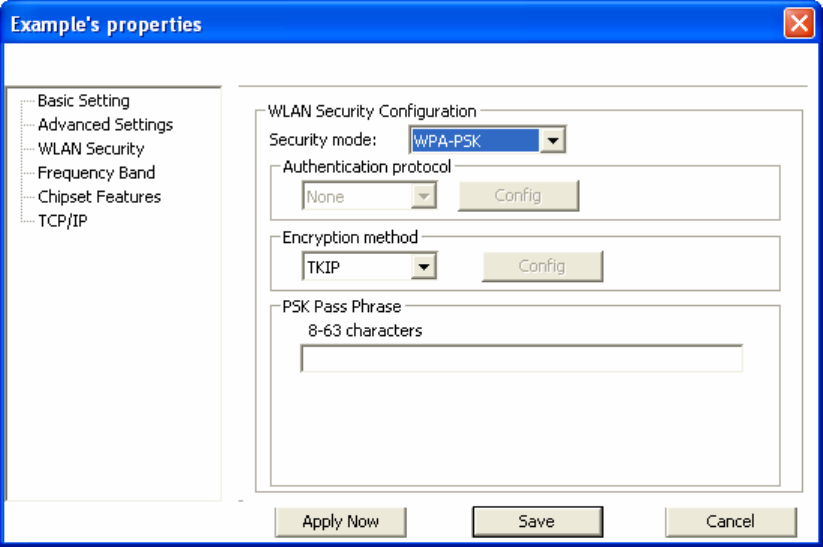
8
Manual Input (Hexadecimal): You generate your own WEP Key using hexadecimal
characters (10 characters for 64-bit, 26 characters for 128-bit, 32 characters for 152-bit).
5. Click [OK] to save your settings and return to the previous screen.
6. If you want to use 802.1x authentication with WEP, you will need to configure your 802.1x
settings. Please see section 4.5 for details on configuring 802.1x.
Configuring WPA-PSK
1. Select [WPA-PSK] under [Security Mode].
2. Select [Encryption method]. You can choose between TKIP or AES. Most access points
use TKIP for WPA-PSK.
3. Under [PSK Pass Phrase] enter the same pass phrase used to configure WPA-PSK on
your access point.
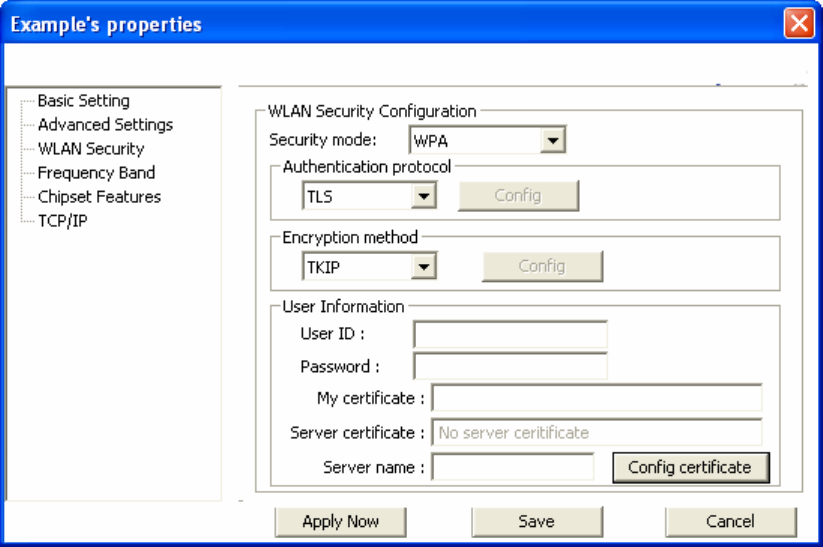
9
Configuring WPA
1. Select [WPA-PSK] under [Security Mode].
2. Select [Encryption method]. You can choose between TKIP or AES. Most access points
use TKIP for WPA.
3. See section 4.5 for configuring 802.1x for WPA.
Configuring 802.1x
1. Choose the EAP method under [Authentication protocol].
2. Depending on the EAP method chosen the options under [User Information] will change.
Configuring 802.1x – EAP-MD5
1. EAP-MD5 is only a choice when use WEP. MD5 is not allowed for WPA.
2. Enter in unique User ID and Password under [User Information]
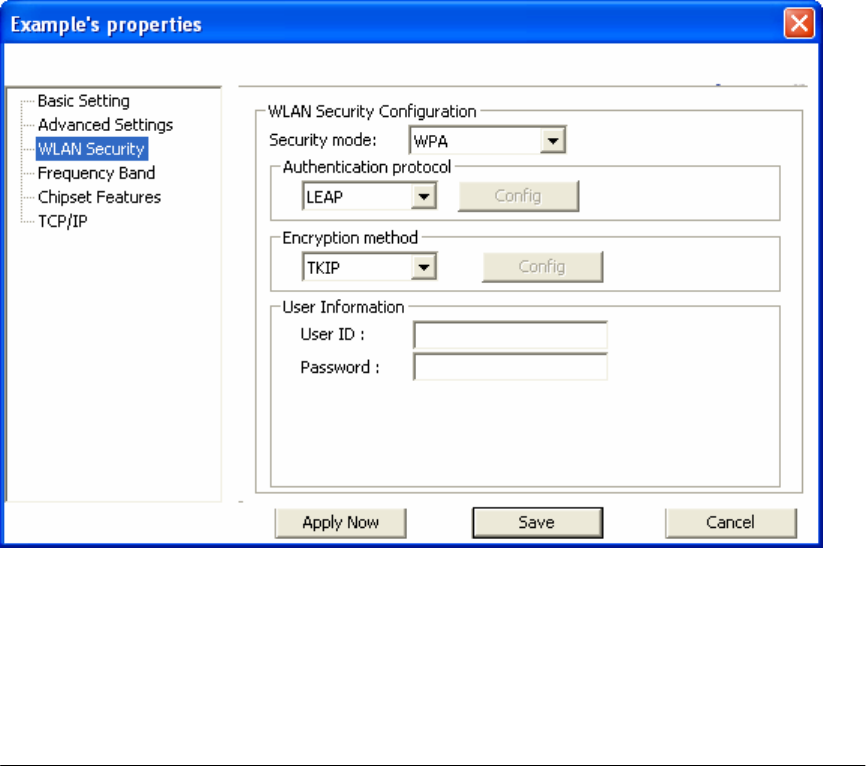
10
Configuring 802.1x – EAP-LEAP
1. Enter in unique User ID and Password under [User Information]
Configuring 802.1x – EAP-PEAP
1. Click [Config] under [Authentication protocol]
2. Select inner PEAP protocol. You choices are [MS-CHAP v2] or [TLS].
3. Click [OK] to finish and return to the previous screen.
4. Enter in unique User ID and Password under [User Information].
5. If using a user6 or server certificate click [Config certificate]. The following window appears:
6 You must first have a wired connection to a network and obtain the certificate(s) from a certificate
authority (CA). Consult your network administrator for more information.
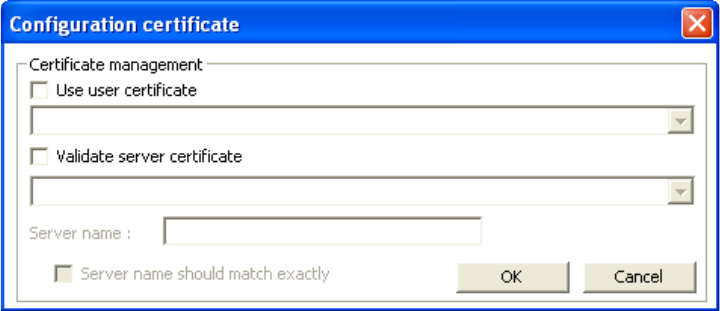
11
[Use user certificate]: Put a check in the box to activate user certificate. Then select certificate from
the pull down menu.
[Validate server certificate]: Put a check in the box to activate server certificate. Then select the
certificate authority from the pull down menu.
[Server name]: Name of server used for 802.1x authentication.
[Server name should match exactly]: Check this box to force server name to match exactly the
same in the certificate.
6. Click [OK] to finish and return to the previous screen.
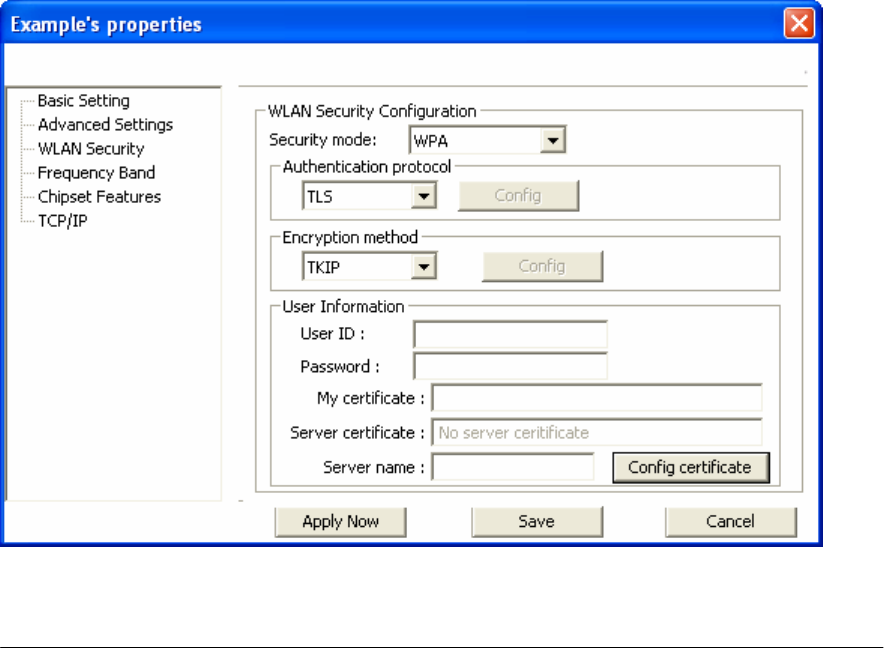
12
Configuring 802.1x – EAP-TLS
1. Enter in unique User ID and Password under [User Information].
2. TLS requires you to configure both a server and user7 certificate.
3. Click [Config certificate]. The following window appears:
7 You must first have a wired connection to a network and obtain the certificate(s) from a certificate
authority (CA). Consult your network administrator for more information.
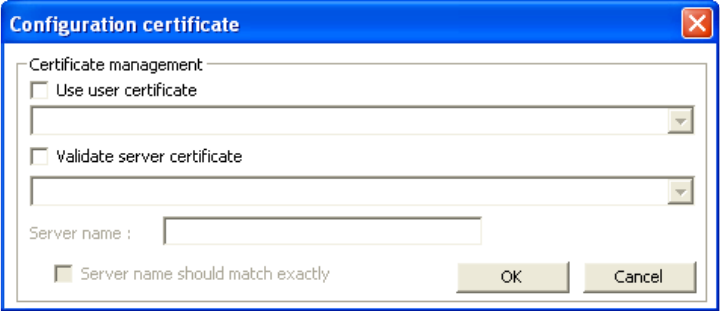
13
[Use user certificate]: Put a check in the box to activate user certificate. Then select certificate from
the pull down menu.
[Validate server certificate]: Put a check in the box to activate server certificate. Then select the
certificate authority from the pull down menu.
[Server name]: Name of server used for 802.1x authentication.
[Server name should match exactly]: Check this box to force server name to match exactly the
name in the certificate.
4. Make selections and then click [OK] to finish and return to the previous screen.
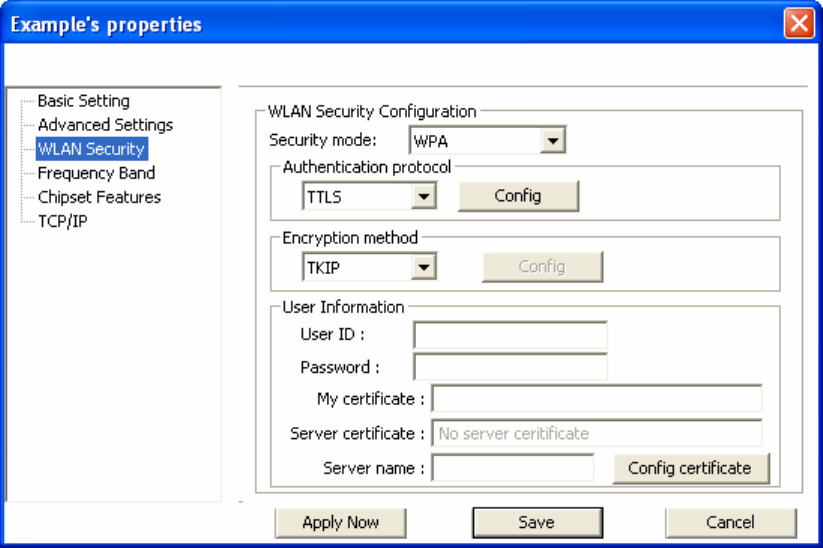
14
Configuring 802.1x – EAP-TTLS
1. Enter in unique User ID and Password under [User Information].
2. Select inner TTLS protocol. You can choose between [PAP], [CHAP], [MS-CHAP],
[MS-CHAPv2], or [MD5-Challenge].
3. Click [OK] to finish and return to the previous screen.
4. Click [Config certificate]. The following window appears:
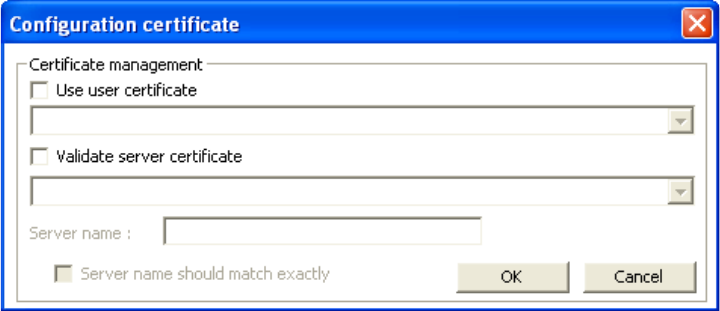
15
[Use user certificate]: Put a check in the box to activate user certificate. Then select certificate from
the pull down menu.
[Validate server certificate]: Put a check in the box to activate server certificate. Then select the
certificate authority from the pull down menu.
[Server name]: Name of server used for 802.1x authentication.
[Server name should match exactly]: Check this box to force server name to match exactly the
name in the certificate.
5. Make selections and then click [OK] to finish and return to the previous screen. Server
certificate must be configured for TTLS to work.